The Productivity Commission (PC) has released a new research paper, entitled Housing Decisions of Older Australians, which examines the factors influencing the housing choices made by older Australians along with the intersection between the tax and transfer system.
The Paper finds that “the vast majority of older Australians are living in private dwellings, and about 80 per cent own their home”. Around 75% of older Australians aged over 75 also live in detached houses and a similar proportion have homes with three or more bedrooms, suggesting significant spare capacity (see next chart).
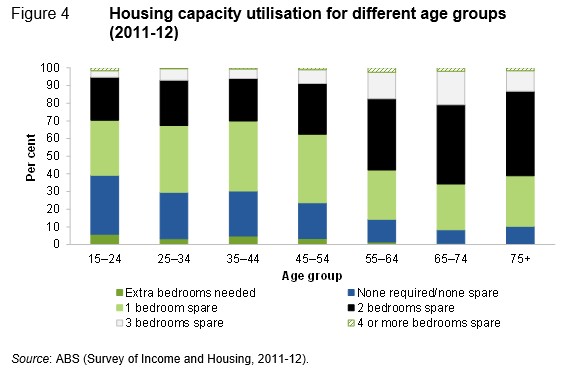
Most older Australians are also reluctant to downsize during their retirement (see next chart).
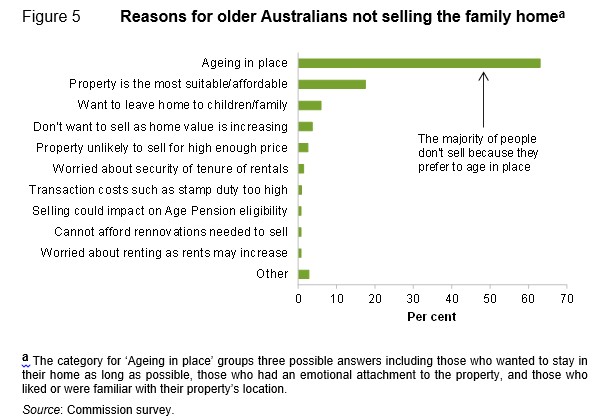
Older Australians are also generally very wealthy, but income poor, when compared against their younger peers:
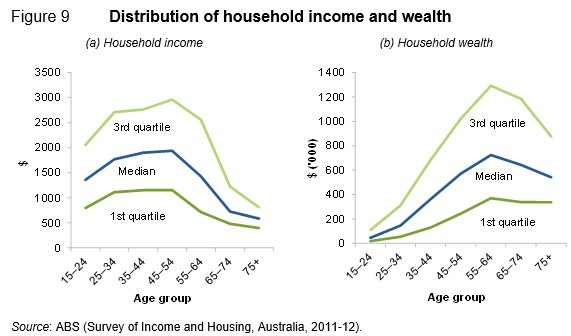
And yet they refuse to tap their housing wealth (see next chart).
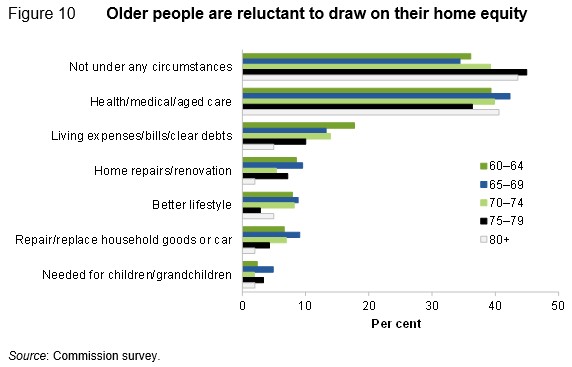
The PC is scathing of state government planning regimes, which hinder downsizing and the provision of retirement homes:
Operators of retirement villages and aged care services reported significant red tape in dealing with planning and development approvals, both for new facilities and for modification and redevelopment of existing outdated stock. Age specific housing development is often disadvantaged relative to other housing or commercial development. Planning rules that constrain the development of smaller, higher density residential properties inhibit downsizing, and innovative housing proposals often face NIMBY opposition. The desire of most older people to age in place strongly signals a need for revision of state and local government planning regimes, to reduce the barriers to the supply of new housing options. Reforms in this area could potentially deliver the greatest gains in affordability and diversity of housing options for older Australians.
Tax and transfer policies also encourage older Australians to stay put in their large family-friendly homes:
At the Australian Government level, owner occupied housing enjoys favourable treatment on both the taxation and transfer sides of the budget. The principal home is exempt from the means tests for the Age Pension. It is also exempt from capital gains taxes that apply to the sale of many other assets. There is also a range of government support arrangements for other forms of accommodation and aged care, for which the means tests treat owner occupied housing favourably, or exclude it altogether. On the other hand, at the state and territory governments level, conveyances of residential property are subject to stamp duties. The complex interplay of these policies can distort housing decisions and lead to inequitable outcomes.
The PC recommends replacing stamp duties, which hinder mobility, with a broad-based land values tax:
Multiple reviews have recommended the abolition of stamp duties, and there is a strong case to do so in principle. The lost revenue from this change could be recouped through extending the scope of state land taxes to principal residences. Land taxes are a far more efficient tax than stamp duties and the change offers an opportunity to improve overall efficiency, and remove a secondary impediment to optimal housing decisions for older Australians.
There are some implementation challenges in moving to a broad based land tax, including cash flow concerns for low-income retirees living in high-value family homes. One option to address this concern could be to allow low income older people to defer payment until the dwelling is eventually sold. A small number of local governments around Australia have already implemented similar schemes for council rates.
The PC also recommends eventually including the family home in the assets test for the Aged Pension:
…its exemption from the Age Pension means test creates an incentive for over investment in principal residences, discourages downsizing and generally reinforces the perception that the family home should not play a role in the retirement funding mix. In effect, by giving home ownership a special status, the means test distorts and constrains the range of accommodation and retirement income choices of older Australians. The exemption is also inequitable — it favours home owners over non home owners, who are typically less wealthy and possibly in greater need of assistance…
Removing the family home exemption would be the most efficient and equitable outcome, but this appears intractable in the immediate future. At a minimum, there is a strong case on equity grounds to set a limit on its value…
Including the family home in the assets test would reduce the proportion of people on the Aged pension to 62.3% from 73.3% currently:
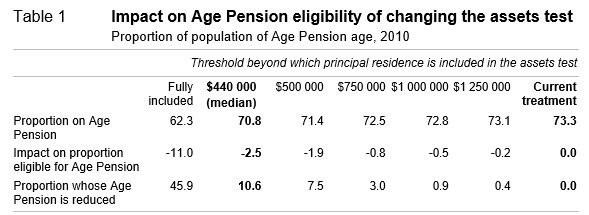
Adam Creighton at The Australian says this would save the Budget around $6 billion per year.
The PC also notes that most older Australian home owners on low incomes could boost their retirement living standards by drawing on their home equity. However, the reverse mortgage market is small and underutilised. In particular, “reverse mortgage products are inherently more expensive than standard mortgages because they place longevity and (perhaps) housing price risks on the financier, and the resultant higher interest rates and fees are an unavoidable barrier to greater demand”.
Regular readers know my views on this issue. With around 80% of retired Australians owning their own homes of which $926 billion in equity is locked up, and the cost of the Age Pension ($43 billion per year) being the largest and one of the fastest-growing Budget expenses, reform must be made a priority. My solution is:
- For one’s principal place of residence to be included in the assets test for the Aged Pension at some point in the future (e.g. 1 July 2020), thus allowing current retirees and prospective retirees adequate time to make arrangements.
- Replacing stamp duties for everyone with a broad-based land values tax.
- Extend the existing state sponsored reverse mortgage scheme, the Pension Loans Scheme, to all people of retirement age so that asset (house) rich retirees can continue to receive a regular income stream in exchange for a HECS-style liability that is recoverable from the person’s estate upon death, or upon sale of the person’s home (whichever comes first).
Under such a plan, pensioners could continue to receive an income stream as they do now under the Aged Pension, but with less drain on the Budget and on younger taxpayers. The stamp duty to land tax switch would also deliver more efficient use of the housing stock.
The economics is simple. Unfortunately the political economy is not. Watch retirees fight like wounded bulls against reform.

